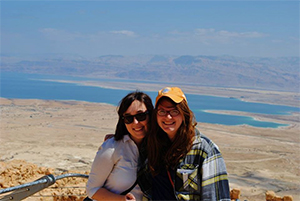UT Graduate in Judaic Studies, Lily Dropkin, visits Israel
 Imagine that you live in a house, a beautiful mansion made in the eighteenth century. What do you do if that house begins to fall apart around you? You call a repairman, right? Now imagine that that same house is in Israel, and it is part of a building from the Crusades. Then who do you call? Probably not that same repairman. In this tiny country in the Middle East, you'd have to call a conservator, to rebuild walls with historically accurate mortar and similar materials. That's what I'm learning to do.
Imagine that you live in a house, a beautiful mansion made in the eighteenth century. What do you do if that house begins to fall apart around you? You call a repairman, right? Now imagine that that same house is in Israel, and it is part of a building from the Crusades. Then who do you call? Probably not that same repairman. In this tiny country in the Middle East, you'd have to call a conservator, to rebuild walls with historically accurate mortar and similar materials. That's what I'm learning to do.
All over Israel there are ancient ruins, buildings that the government wants to use for tourism, but first they need to be stabilized so that they are safe for visitors and don't decay more over time, and sometimes need to be restored for the optimal tourist experience. I've learned to mix mortars, document sites by hand and with graphic imaging technology, and even how to chisel stone blocks. Just this last week, I took part in the Israeli Antiquities Authority's conservation efforts in Caesarea, one of the most famous ancient cities in Israel. Using a multitude of techniques, we rebuilt the inside of a Crusader wall, fixed broken and cracked stones, as well as chiseled out damaged areas of the wall.
But the most captivating part of this experience is the wealth of history within this country. The entire old city of where I live is designated a World Heritage Site by the United Nations, a title which it easily merits. Layers and layers of history encapsulate this city, from a Crusader Citadel beneath the modern streets and homes, to churches placed one on top of the other for centuries. This is only compounded in other parts of the county, where tels cover centuries of settlement in Israel. Conserving all of this seems to be a hefty task, but it is one that I'll gladly take.